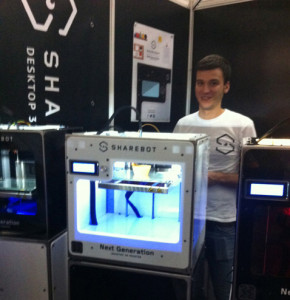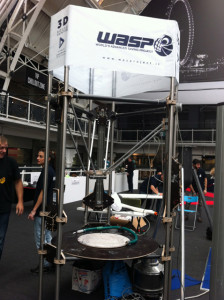Through Shane’s interview with 3D Hubs and Rachel’s examination of the 3D Hubs Trend Report released this month, we picked up on an interesting area of activity. As Brian Garrett, one of the company’s founders, pointed out, “We do see that specific countries have their own favourites when it comes to 3D printers.” Despite the rise of globalization and the relative shrinking of space, due to the Internet, consumers maintain allegiance to their local brands, at least when it comes to 3D printing. As a result, in countries like Italy — if 3D Hubs’ approximate 1,600 users is a representative sample — 3D printer users are sticking to the machines of their native countries.
So, with Italy as a case study, we might ask ourselves, “why are we seeing a return to domestic manufacturing?” According to Garrett, in Shane’s interview:

After chatting with our Italian interns Simona & Simone we’ve identified some key insights, which can be mainly attributed to influential Italian people in the 3D printing field that act as evangelists, such as: Massimo Banzi, one of the founders of Arduino, Alessandro Ranellucci, founder of Slic3r, and Riccardo Luna, director of Wired Italy.
In addition, several 3D printers and maker projects have Italy as their homeland such as Sharebot, Kentstrapper and Wasp. Finally, in Italy the art of making is greatly developed over the centuries. Craftsmen have updated their techniques to the most innovative ones, for example Maketank, a marketplace in which Italian artisans sell their products.
Machines by both Sharebot and WASP, which Rachel got to see in person at the 3D PrintShow, are pretty neat. Sharebot moved from wood paneling to a stainless steel frame with plexiglass panels and now sells a consumer-friendly, untethered device with LCD screen, 200mm3 build volume and the ability to print multiple materials with an SD card. Not something to scoff at.

WASP produces machines that may be even more unique, like the PowerWasp and Personal Fab Evo, which have interchangeable heads for 3D printing and milling. The company also demonstrated their deltabots at the 3D PrintShow, which create ceramic 3D prints. In addition to the smaller delta they displayed, they exhibited one with a build area of 2000mm3 for huge prints. This machine will, hopefully someday, be accompanied by a pyrolytic stove, a zero emissions stove for baking ceramics and creating energy. The company is also pursuing the development of a Direct Light Processing (DLP) 3D printer for curing photosensitive resin using projected UV light. Altogether, WASP is an ambitious group of designers.
So, with Italian consumers seeking out Italian designs, in addition to the influential Italian innovators behind Arduino and Slic3r, is this representative of the country’s knack for design? It’s certainly true that Italy is often at the cutting edge of a variety of industries; their artisans are world-renowned and we’ve seen what they can do with automotive design. Perhaps the country adopted 3D printing before many others and, thanks to their keen manufacturing skills, Italian consumers know better than to purchase 3D printers from other nations. If that’s the case, then what accounts for Brian Garrett’s other observation: “… we do see that Ultimakers and Leapfrog printers are especially popular in the Netherlands. In the US we see a strong dominance of Makerbot.””
The reasons for this are probably manifold. On the one hand, it’s possible that, as a species once anchored to local products out of necessity and a lack of technological progress, we’re stuck in our ways, championing local brands because they’re nearby and we feel comfortable with them. The marketing of those machines is in our native tongues, as is the documentation, and so it makes sense to buy them.
On the other hand, ever since Deng Xiaoping heralded in a new era of Chinese capitalism with the phrase, “Who cares what colour the cat is as long as it catches mice“, manufacturing has become even more international, with outsourcing from 1st world countries to the developing world often dropping production costs and saving consumers money. In the world of mass production, it would seem logical that consumers of every country everywhere would buy Up! brand 3D printers made in China. Another possibility, then, is that we’re seeing a move back towards local manufacturing tied to 3D printing, as Barack Obama (and I’m sure other heads of state) promised.
One of the great dreams of 3D printing, for some, is a network of distributed manufacturers. With 3D printing hubs offering locally produced goods, the economic and ecological costs of shipping would be reduced dramatically. Fewer trucks, ships and planes transporting merchandise (aside from raw materials) means less of a carbon footprint and fewer fees for delivery. For those who truly believe in the power of distributed manufacturing, however, there are more powerful political and social implications.
The 3D Hubs Trend Report indicates that “Open Source based RepRaps and Ultimakers are both bravely holding significant market share in a market that is targeted by 3D printing giants Stratasys (5.1B USD market cap) and 3D Systems (6.5B USD market cap).” We’re still in the early stages of desktop 3D printing, so it’s possible (as my dad suggests) that smaller manufacturers will be absorbed by larger ones. For instance, Ultimaker could be acquired by 3D Systems to compete with Stratasys’ Makerbot. If we maintain the models of the late 20th Century, days of exploding monopolies and megacorporations that gobble up smaller businesses like Kraft-owned Oreos, this would likely be the case. The Internet is still young though and web 2.0 is even younger.
Given that, before 1953, there was no such thing as TV broadcasting, before the 1990s there was no such thing as the Internet, and before 2007, there was no such thing as an iPhone, it’s possible that tomorrow will not be like yesterday. We take for granted that life features some predictable patterns, but are unprepared for the surprises. What I mean to say is that the economic models of the late 1900s, like our technologies and ways of life, may change. As a result, not every small business will be swallowed up. Though they are profitable for some, large corporations do not meet all of a consumer’s needs, may be sluggish when it comes to change, and certainly don’t have the interests of local populations at heart. Instead, people may begin to favour their local 3D printer retailer over some mass-produced, quality un-assured name brand.
Embedded in the Maker movement associated with desktop 3D printing (at this stage), is the creation of community. There’s only so much that you can accomplish alone at your computer. Visit your local hackerspace, however, and you can exchange skills with people who know how to solder wires, build structures and program software. At the same time, you exchange jokes, ideas and social support. So, when you buy a 3D printer born from your local hackerspace, you’re not supporting some faceless corporation, but a friend.
As a result, and these are some of the political reasons at the heart of distributed manufacturing advocates, you’re also supporting local control. You bring manufacturing back to, not only your country, but your neighborhood ensuring that oversight of and accountability for local companies is easier to maintain. If your local Hackerspace produces a defective 3D printer, it may be less difficult to remedy the problem with them than calling a help-line robot and screaming profanity until you’re directed to an operator, only to be told that the part you’re looking for is out of production. And, when it comes to even larger issues — oil spills, nuclear meltdowns, greenhouse gas emissions — town meetings rather than time-intensive, costly lawsuits could act as the solution.
Local control means democratic control, taking power from unaccountable tyrannies and placing it in the hands of regular individuals and communities. Even WASP, with its products proudly made in Italy, isn’t looking at the issue from a nationalistic perspective. Their “manifesto” reaches all of the way from the psychological to the social to the ecological:
1) Everything is mind, everything is change, reality is the result of shared thoughts. The WASP project is a humanistic experiment; sailing between art and science, economy and politics, we plan sustainable models and systems, sharing our vision.
2) Nowadays who’s rich has more opportunities, this leads to monopolies and social inequity infecting life quality. WASP project, independently of social and economic classes, with a perspective of equal opportunity and meritocracy wants to give an economical value to knowledge commitment and sharing.
3) Our planet resources aren’t sufficient for the current demographic explosion, we need to change our development models. WASP project studies, realizes and sponsors eco-friendly systems.
4) The house is a primary need and a right, WASP project suggests a process for realizing houses for a very low price; we are self-founding the project evolution by selling ou developed systems.
5) Power of money and finance is based on the monopoly of industrial production, WASP project works to let people produce what they need.
6) Once everyone is going to be able to build what they imagine, property and poverty will belong to the past. WASP project spreads knowledge and systems to give shape to ideas.
7) The WASP project works to realize and diffuse the most advanced technologies and let everyone use them; equal opportunities to free creativity and relaunch the (new) economy from the bottom.
The answer to why we people buy local isn’t out of national pride or faith in our own country’s production abilities, it’s about social evolution. We’re buying and making locally because only now, thanks to the spread of information and knowledge via the Internet, we’re thinking globally.



